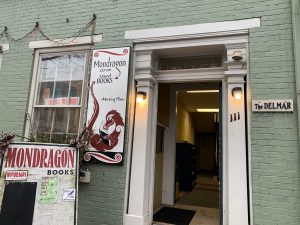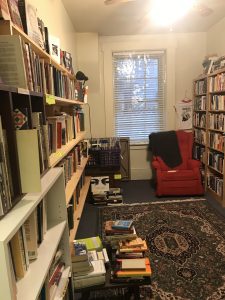Nestled in the heart of Central Pennsylvania, the borough of Lewisburg sits alongside the Susquehanna River. Incorporated in 1812, Lewisburg was born out of a river town and soon began to grow. With the canal being built along the banks of the river, and then the railroads coming into the picture in the late 1800s, the town became the industry town in the area. With new business come expansion of population, stores, and the newly incorporated Bucknell University, which is located just south of the borough line. As the town grew in the early 20th century, the main business district began to form along what is now called Market Street (previously Main Street). With this growth and development splurging late into the 1900s, business stretched away from the two block cluster (between 3rd and 5th street) to the full length of Market, including the current sight of Mondragon, a locally owned used book store.
With Lewisburg being a river town, there is some sever downsides, which the town has dealt with numerous times: flooding. With Bull Run creek running right through the business district and the Susquehanna to the town’s east, Lewisburg got severely damaged in both the 1936 and 1972 floods. But, with the tight knitting of the community and the hard work of everyone, Lewisburg bounced back and became even stronger for the generations to come.
When you ask someone if they’re from Lewisburg and they tell you “yes,” what they probably mean is that their parents are from Lewisburg, and so are their grandparents, and possibly their great-grandparents. They mean that this heritage, the ability to say that they are “from Lewisburg” was passed down to them, a tradition given to them by the family that came before. Most of Lewisburg is like this. It’s a place where people don’t really leave and, if they do, they come back when they’re ready to have families of their own, and pass it down to their own children.

This inheritance tradition that permeates Lewisburg has made it the perfect place for a bookstore like Mondragon. It’s similar to the way Sarajane runs her shop, allowing Mondragon to be a place of family and tradition, somewhere for the customers to feel at home. If you find a book at Mondragon (with the collection Sarajane has, it is almost guaranteed you will) it’s possible to negotiate the price with Sarajane. Volunteering at Mondragon gets you a coupon for a free book. It’s a process not dissimilar from going to your grandma’s house and coming home with whatever trinket she gave you to keep. Like that trinket, that inheritance gives the book new life. As Benjamin says, “I am not exaggerating when I say that to a true collector the acquisition of an old book is its rebirth. This is the childlike element which in a collector mingles with the element of old age. For children can accomplish the renewal…” (Benjamin, 61). Literature is brought back to life in Lewisburg through Mondragon and the way it inherits books. It adds meaning to Lewisburg as a place.
This meaning is something that Cresswell notes when he says, “This…space has a history–it meant something to some other people…Now what do you do?…You could add your own possessions…arrange a few books purposefully on the desk. Thus space is turned to place. Your place” (Cresswell 2). This acquisition of something that belonged to somebody else but now belongs to you, this inheritance, can be made your own, and thus be given new life. The people of Lewisburg, through their inheritance tradition of passing the town down to their descendants, turned the space of Lewisburg into place. Likewise, Sarajane has turned Mondragon from a space—where people can go to buy books—into a place where books are passed down. And that means that book are something that are passed down. They are something intimate, given to you by someone special, a shared experience between the two of you. An experience created by Lewisburg itself, and an experience created by Mondragon.
The modern Mondragon is not the same store as the one Charles Sackrey created and not the store that Sarajane inherited. A quick history of the space the bookstore. At first the space was a doctor’s office, the front room being the waiting room, the side room being the receptionists office, and the remaining two rooms being the examination rooms. After that, it became the headquarters for the Democratic party in Lewisburg right around the time in which Obama was running for president. After that, Charles Sackrey took over the space and created Mondragon Used Bookstore.
And now for the history of the bookstore itself. Charles Sackrey, at the time a professor at Bucknell University but later retired from teaching, opened Mondragon, naming it after the largest co-op in Spain. Sackrey taught many classes, two of which being “Classical Marxism” and “Theatre and Economics.” Charles Sackrey was known to discuss Marxist theory in depth with customers that came in. He hired his friends to work alongside him as clerks to the store. And, together, they ran the store for years to come. Until Sarajane came in and inherited the store from Charles Sackrey.
Unlike the sort of cultural adoption that took place when Charles Sackrey used the name “Mondragon” and the ideals of a socialist society to form his bookstore’s identify, the current owner, Sarajane, inherited Mondragon. Although she isn’t related to Charles Sackrey, it happened that she was available to the bookstore just as he was searching for a way to retire. His friends were all around the same age as him and therefore had no more energy or interest in actually owning the store than he did, but when he asked Sarajane, who enjoyed the store and felt she had nothing else to do at the time, she accepted the charge.
This passing-of-hands, while not normally what comes to mind with the word “inheritance,” is in line with many fictional renditions of bookselling, which push literary inheritance as a matter of culture rather than personal relationships. Lisa Morton’s short story “Blind Stamped,” for example, illustrates the way a bookseller becomes inextricably bonded to a mostly anonymous customer named Rick Herson. Although he knows nothing of the man except his name–learned from a receipt–the bookseller, Nathaniel, finds himself the sole “heir” of Rick’s book collection after he dies. So we see that literature provides more types of inheritance than the standard type written in a will. It provides, for example, the passing of a bookstore to someone with no relation to the previous owner.

In the case of Mondragon, Sarajane’s personality and background felt in line with the bookstore’s character, and so its previous owner passed it down to her as readily as he might have passed it down to a daughter. The fact that they bear no relation obviously meant nothing to Charles Sackrey. In that moment, when it counted, they shared a deeper bond than blood. They shared a willingness to put books in new hands, passing stories and histories onto the next generations.
The store runs on used books. Their entire stock is made up of works given to the store by regulars. Some may think that this practice would lead the store to be empty or not well-rounded in it’s collection. But the store is full to the brim. Charles Sackrey gave an unkempt store to Sarajane. Sarajane fixed it all up, but the store still remains full to the brim. Benjamin made an argument on the inheritance of books and how it is the best way to create a collection. He says,
“Actually, inheritance is the soundest way of acquiring a collection. For a collector’s attitude toward his possessions stems from an owner’s feeling of responsibility toward his property. Thus it is, in the highest sense, the attitude of an heir, and the most distinguished trait of a collection will always be its transmissibility.” (Benjamin 66).
In 2009, the interior space of Mondragon was documented in low-quality YouTube video titled “Mondragon Bookstore Film.” While the title suggests videography, it appears to be a series of photos strung together to make a “film” and includes Comic Sans credits, reminiscent of the early 2000s digital space. Charles Sackrey, the original owner, is present in a few snapshots of the film, along with customers who use the space to converse and read. Snyder did not choose to continue the YouTube channel when she took over the store because this is the only video posted by Mondragon. Although that is the case, it is clear that Snyder inherited the “fiercely independent” personality of the store. In the video, certain photos were chosen to highlight the store’s core values. In one clip, there is a customer reading a book titled Idiot America. The choice in book is not accidental and demonstrates that Mondragon is a safe space to criticize politics. In another photo, there is an image of a book titled Urgent Message From Mother: Gather the Women and Save the World. This book provides a unique view that supports feminism and mirrors Snyder’s need to promote underrepresented voices. The owner said that she tries to equip the store with books written by women or by authors of color to expose readers to new ideas that are not necessarily welcomed into the hallowed shelves of corporate bookstores. Snyder inherited Sackrey’s core values for Mondragon, seen in the similarities between the book choices for the store, even though she chose to not continue the YouTube channel.
In the front hallway of the shop rests a couple of shelves filled with cheap books. These books are strategically placed outside of the main part of the store because Snyder is aware that these books are unlikely to appeal to most people. Additionally, the owner knows that people will come in during off-hours (the hallway remains unlocked) and steal books, but she is not overly concerned about it. Snyder is fully aware that the store will not be making a huge profit off of them.
Snyder’s willingness to let books go is unlike traditional means of collecting. To an extent, the bookstore is similar to a museum space because both are in the business of preserving culture. Arthur James Clifford discusses the ways in which society impacts culture in the book The Predicament of Culture: Twentieth-Century Ethnography, Literature, and Art. Most collectors try to tie in each item of a collection to a specific narrative that is not always accurate (Clifford 244-246). While she did inherit the books of Mondragon, Snyder realizes that each book does not necessarily have a home in the store. This is what allows her to let go of certain items and not hold onto something for its supposed intrinsic value.
Following the front hallway, the front room of Mondragon is the temporary home to a hodge-podge of items, all reflecting Snyder’s core beliefs about farming and being self-sufficient (Snyder). This is different than Sackrey’s version of Mondragon because Snyder rearranged the front room to fit her vision. While each book in the store is inherited to some extent, Snyder has recreated the visual placement of her inheritance to represent her beliefs in Mondragon.
Next, there is a side room that consists of books about travel, history, and economics. On their face value, most of these books seem boring, even Snyder mentioned that she wants to change this part of the store (Snyder). This room is reminiscent of Sackrey’s ideal bookstore because Snyder has not had the chance to rearrange the space to fit her values. There are two conflicting values in the bookstore that are able to live in partial harmony, or at least until Snyder finds the time to rearrange the store.

Opposite of the side room is the middle room. This area holds the most diverse categories of books with philosophy, spirituality, film, theatre, fine art, graphic novels, and culture. First glance of the room made me wonder, were these placed in the same room because Snyder found similarities between these books and/or their authors or were they randomly placed because this is the second biggest room in the store? The importance of this room is not about the inheritance of these books, but the inheritance of knowledge given from each book. These pieces of literature obtain significant lessons on current events and are sure to better one’s knowledge of the ever changing world around them.
Shockingly enough, the back hallway leading to the final room in the store is occupied with as many books as it can hold. This passageway to the final room is the most unsystematic room of all, for none of these books correlate to each other. However, Walter Benjamin wrote, “what else is this collection but a disorder to which habit has accommodated itself to such an extent that it can appear as order?” (Benjamin). There are three bookshelves: one tall, one medium and one short. Each shelf is filled to capacity with literary bios, books about baseball, humor, and literary criticism. These are four very different genres of books to place together. To add onto the randomness of the hallway, a map of the world is hung proudly on the wall facing those shelves. Snyder made sure that there are absolutely no blank walls in this store. For those who love to browse book stores will be delighted to see what Snyder has in stock.
The last room in this store is the backroom. This room consists of fiction, poetry, memoirs, fantasy, and children’s stories, along with vinyls to highlight the uniqueness of Mondragon. Additionally, there are handmade vinyl coasters for sale on the shelves that give the room a very old school feel to it. In contrast to these lively upbeat records, this room happens to be the quietest of all because it’s hidden away. It is hard to imagine many customers visiting the backroom seeing that other elements of Mondragon distract from this space. However, customers would be pleasantly surprised by the peaceful 80’s vibe the room gives off.
And now, for all those who come and go through Mondragon’s double doors, a part of the bookstore carries on. After spending a semester studying it, learning to love it, and coming to appreciate where it fits into the bigger picture of bookselling, we will hold a part of it in our hearts and pass it on, in turn, to the next.

___________________
TEXTS
Benjamin, Walter. Illuminations: Essays and Reflections. Edited by Harry Zohn. Translated by Hannah Arendt, Schocken Books.
Clifford, James. The Predicament of Culture: Twentieth-century Ethnography, Literature, and Art. Cambridge, Mass: Harvard University Press, 1988.
Cresswell, Tim. Place: a Short Introduction. Blackwell Pub., 2009.
Morton, Lisa. “Blind Stamped.” Shelf Life, edited by Greg Ketter, Prime Books, 2002, pp. 131–145.
Sauers, Richard A. Images of America Lewisburg. Publishing, Arcadia. 2010
___________________
INTERVIEWS
Snyder, Sarajane. Personal Interview. 22 February 2019.
___________________
GRAPHICS
Photos courtesy of the Mondragon Group.
Photo of Sarajane Snyder courtesy of Mondragon Books Instagram.


0 Comments